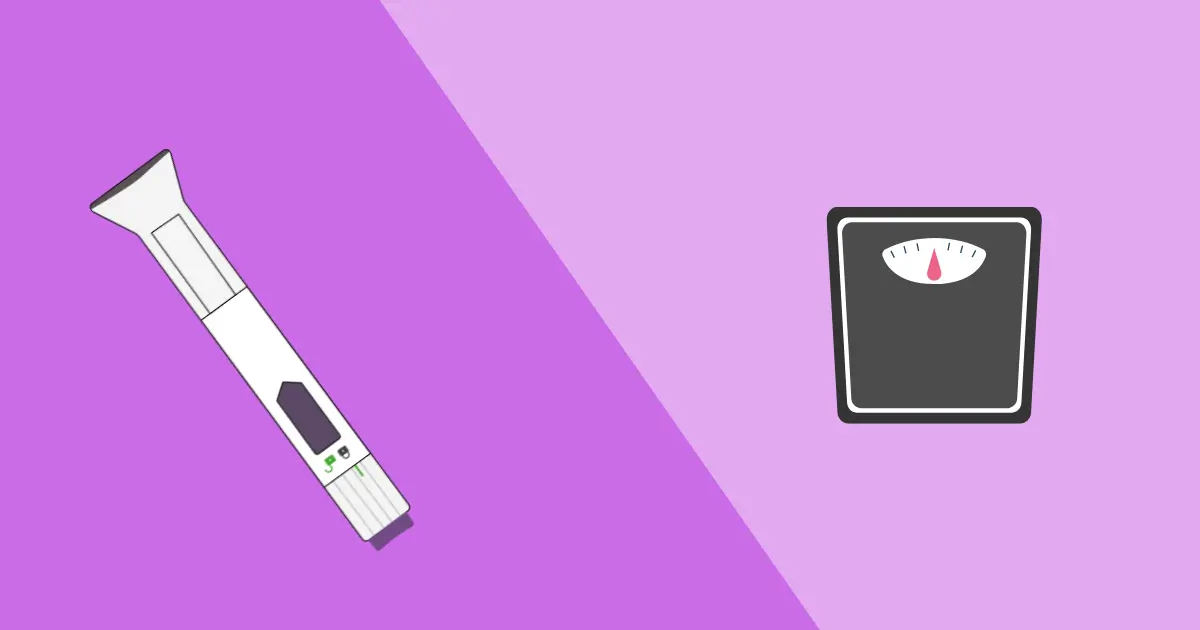Mounjaro weight loss by week: What the science says
Curious about what to expect to happen, week by week, on a Mounjaro weight loss journey?
Key highlights
- Mounjaro (tirzepatide) is a dual receptor agonist that works on the GIP/GLP-1 receptors in the body to regulate blood sugar levels, reduce appetite, and promote satiety.
- Patients typically lose 1-2% of their baseline body weight in the first few weeks, followed by more weight loss as the dose increases.
- The weight loss may vary among individuals based on their diet and workout routine. Research shows that you can lose up to 22.5% of your starting body weight after 72 weeks of treatment on the highest maintenance dose of tirzepatide.
- Always consult your doctor before starting the medication and report any serious side effects.
Mounjaro (tirzepatide) is a dual receptor agonist that acts on the glucagon-like peptide-1 (GLP-1) and glucose-dependent insulinotropic polypeptide (GIP) receptors to regulate blood sugar levels in patients with type 2 diabetes. It helps regulate insulin levels, slow gastric emptying, and influence satiety signals in the brain, leading to reduced food intake and improved metabolic efficiency. Zepbound, another drug with the same active ingredient, is approved by the U.S. Food and Drug Administration (FDA) for the treatment of obesity and overweight. Patients taking Mounjaro also experience weight loss, along with blood glucose regulation.
Patients often wonder, “How much weight loss should I expect with Mounjaro?”
This article shares a periodic weight loss journey on taking Mounjaro. While all patients taking the medication may not lose the same amount of weight over time, we’ve considered trial data and common patient experiences to help you understand what to expect. Here’s what you’ll get to know:
- Early-week weight loss expectations
- Typical weight loss ranges on different doses throughout the titration schedule
- Weight loss plateaus and why progress slows
- When to see your healthcare provider
After reading this guide, you will have a clear picture of how Mounjaro works and a realistic, week-by-week roadmap of what to expect on your tirzepatide journey.
Understanding the science: How Mounjaro causes weight loss
Mounjaro (tirzepatide) is a dual receptor agonist drug that mimics the action of glucose-dependent insulinotropic polypeptide (GIP) and glucagon-like peptide-1 (GLP-1) in the body. GIP and GLP-1 are incretin hormones that increase glucose-induced insulin release. Meanwhile, GLP-1 signals satiety by activating the peripheral GLP-1 receptors and influences hunger signals through GLP-1 receptors in the brain. Medications with tirzepatide as the active ingredient, including Mounjaro, follow the same mechanism of action to regulate blood sugar levels and promote satiety. They reduce hunger, slow down stomach emptying, and help the body use insulin more effectively. Together, these effects lower calorie intake and influence how the body handles energy, leading to weight loss and better blood sugar control.
The Mounjaro Patient Information label mentions once-weekly subcutaneous administration. The drug must be injected into the abdomen, thigh, or upper arm. Tirzepatide starts working within a few hours after administration, reaching its peak between 8 to 72 hours. It has a half-life of about 5 days, explaining the once-weekly dosing.
Patients using Mounjaro may experience weight loss even within the first few weeks, but not instant fat reduction. You might have heard a friend or family member say, “You’ve just lost the water weight,” which could be correct. This usually occurs as a result of glycogen breakdown in the body, which also releases the water attached to it. When you follow a reduced-calorie, low-carb diet, your body breaks down glycogen for energy, resulting in weight loss. Once the glycogen stores are depleted, the body starts burning fat to release energy. Thus, you might experience glycogen and water loss first, followed by fat loss in the following months.
Mechanism of action: GLP-1/GIP receptor agonist
Mounjaro is a dual incretin mimetic that mimics the GIP and GLP-1 hormones your body releases after eating. The dual receptor agonist action helps regulate blood sugar, appetite, and metabolism simultaneously. Key actions of Mounjaro in the body include:
- Boosts insulin secretion: Tirzepatide enables the co-administration of GIP/GLP-1 to regulate blood glucose levels, enhance glucose-dependent insulin secretion, and improve insulin sensitivity. Studies show that insulin sensitivity rises by 65.7% with tirzepatide treatment.
- Suppresses glucagon: Besides stimulating insulin secretion, Mounjaro also reduces glucagon release, a hormone that signals the liver to release glucose into the bloodstream. The suppression of glucagon release from the liver helps maintain steady blood sugar levels by preventing the liver from dumping excess sugar into the blood.
- Slows gastric emptying: GLP-1 RAs increase the transit time of food in the stomach and delay gastric emptying. These medicines also promote a feeling of satiety and fullness, leading to less food intake and efficient weight loss.
- Targets the brain’s appetite centers: Tirzepatide acts on the appetite centers in the brain and stimulates satiety neurons to reduce the “food noise.” Food noise refers to the constant thoughts about eating, including cravings, planning what to eat next, and difficulty stopping eating once started. Regulating these thoughts helps you reduce your food intake and maintain your calorie intake for weight management.
The dual effect of this GIP/GLP-1 mimetic drug helps ensure a natural calorie deficit and regulates blood sugar to promote weight loss and lower blood glucose levels.
What the clinical trials show: percent loss and timelines
Tirzepatide has shown significant weight loss in patients following the titration schedule properly.
The SURMOUNT-1 trial studying the efficacy of once-weekly tirzepatide in adults with obesity or overweight concluded that patients taking the 5 mg, 10 mg, and 15 mg doses lost 15.0%, 19.55%, and 20.9% of their body weight on average, compared to 2.4% in the placebo group, within 72 weeks of treatment.
SURMOUNT-2 trials analyzed tirzepatide versus semaglutide once weekly in patients with type 2 diabetes. Results showed that patients taking 5 mg, 10 mg, and 15 mg of tirzepatide lost 7.6 kg, 9.3 kg, and 11.2 kg on average, in comparison with 5.7 kg weight loss with semaglutide.
The SURMOUNT-4 trial focused on the results of a continued treatment plan with tirzepatide for maintaining weight loss in adults with obesity. Patients taking tirzepatide for around two years lost 25.3% of their total body weight, showing sustained and significant weight loss.
Mounjaro trial results also show the median time to reach weight loss of ≥ 5% was 16.0 weeks for tirzepatide 5 mg and 12.4 weeks for tirzepatide 10 mg and 15 mg, compared to 24.0 weeks for semaglutide 1 mg. While these numbers have been obtained through clinical studies, the progress may vary among individuals.
Mounjaro weight loss timeline: What to realistically expect week-by-week
The Mounjaro weight loss timeline may vary for individuals depending on their starting body weight, metabolism, diet, and exercise. This weight loss journey guide shares the approximate weight loss experienced by patients on Mounjaro.
| Week of treatment | Typical % weight loss range | Approx lbs/week weight loss (for a 200 lb patient) |
|---|---|---|
| 1-4 | 1-2% | 2 lb - 4 lb |
| 5-8 | 2-6% | 4 lb - 12 lb |
| 9-12 | 5% - 15% | 10 lb - 30 lb |
| 13-24 | ~15% | ~30 lb |
| 25-72 | 15% - 21% | 30 lb - 42 lb |
Weeks 1-4 (the 2.5 mg starter dose)
The 2.5 mg dose of Mounjaro is the lowest weekly dose prescribed by doctors as the starting dose. Starting on a low dose helps your body adjust to the weight loss medication and prevents severe adverse reactions. The drug reaches peak concentrations in the blood between 8 and 72 hours, and patients start experiencing appetite suppression.
The STEP-1 trial showed that patients taking GLP-1 drugs (such as Wegovy) lost almost 2 to 8 lb within the first four weeks of their weight loss journey, depending on their baseline weight. Patients may lose 1-2% of their body weight within the first four weeks of using Mounjaro. It is usually because of suppressed appetite and loss of water weight.
Do not be disappointed if you do not observe notable changes in your body weight within the first month. Start building healthy habits, such as a high-protein and high-fiber, but low-calorie diets. When you are unable to eat much, break your meal into small portions throughout the day which also helps with nausea. Drink lots of water to stay hydrated and inform your doctor of intolerable symptoms.
Weeks 5-8 (the 5 mg dose)
After four weeks, healthcare providers typically shift patients to a higher dose, i.e., 5 mg once weekly. The effects are similar to the 2.5 mg dose, but stronger and consistent. You might feel a further loss of appetite and reduction in sugar and fatty food cravings. People typically lose 5% to 6% of their baseline weight by the 8th week. A Reddit user reported losing 2 lbs a month on the 5 mg dose and another mentioned losing 2 kg in 6 weeks.
Patients experience stronger side effects with increasing the dose, such as nausea, vomiting, diarrhea, and constipation. Some also report a complete loss of appetite and aversion to food. However, they usually subside as your body adjusts to the new dose. Take smaller meals and stay hydrated, even if you do not want to eat. Your doctor might continue the 2.5 mg dose for four more weeks in case the side effects are intolerable on the 5 mg tirzepatide dose.
Weeks 9-12 (the 7.5 mg and 10 mg therapeutic dose)
When patients complete their 5 mg dose phase, doctors up-titrate the medication to 7.5 mg or 10 mg for four weeks. Clinical studies show that around 82% of the patients taking tirzepatide lost more than 5% of their baseline weight by week 12. Reddit users call the 7.5 mg and 10 mg doses “game changers.”
Noticeable physical changes
By the 12th week of starting the treatment, patients and their family and friends start seeing notable physical changes, such as loose-fitting clothes. Some patients might experience aggravated symptoms when increasing the dose and observe a visible change in their appearance, including the loss of facial fat.
Metabolic shifts
As patients adjust to the dose, they can tolerate gastrointestinal side effects better and feel more energetic. Some Redditors report the loss of desire for alcohol, nicotine, and caffeine. This eventually also leads to stabilized blood sugar and better sleep.
Consistent weight loss
Losing 1-2 lbs per week is a sustainable pace when using weight loss medication. Make sure to add physical activity to your routine to avoid the loss of muscle mass and maintain a healthy weight. Your doctor might advise you to stay at 10 mg as the maintenance dose or increase it to 12.5 mg if you tolerate the side effects.
Weeks 13-24 (the 12.5 mg and 15 mg maintenance doses)
The next dose after 10 mg is 12.5 mg, followed by the maximum dose of Mounjaro, i.e., 15 mg once weekly. As 15 mg is the highest dose, many patients taking the medication experience a plateau in their weight loss journey. Sometimes, your appetite may return, and you may feel hungrier compared to lower doses. It is important to ensure a healthy lifestyle, including a regular workout routine and a low-calorie diet, to maintain your weight.
Focusing on a protein-rich and low-fat diet can help maintain muscle mass while losing extra fat. A Reddit user, who has been using the 15 mg dose of Mounjaro for type 2 diabetes for a year, mentioned that they lost 70 lbs and are experiencing a mix of effects now. The weight loss plateaus are common, but you may lose further weight on the 15 mg dose. Research published in the New England Journal of Medicine shows up to 15% weight loss by months 3-6 in patients taking tirzepatide.
Weeks 25-72+ (plateau and long-term maintenance)
The effects of Mounjaro have been studied over 72 weeks of the treatment to understand the long-term effects of tirzepatide. Patients taking the 5 mg dose lost 15.0% of their total body weight after 72 weeks of taking Mounjaro. At the same time, those taking 10 mg and 15 mg once weekly lost 19.5% and 20.9% of their body weight, respectively. The report published in the New England Journal of Medicine also shows that 50% and 57% of the patients taking tirzepatide 10 mg and 15 mg lost more than 20% of their body weight. Results conclude that consistent treatment with proper up-titration can help you lose significant weight with tirzepatide. However, the results may vary, and many patients report losing more than 20% of their body weight with consistent treatment.
Patients sometimes experience weight plateaus and struggle to lose further weight after some months. A post-hoc analysis shows that 24.3 weeks is the median plateau time for people in the overweight category. It is important to stay consistent with your workout routine and stay on a low-calorie diet to not gain weight and lose more fat until you reach your weight loss goal.
Mounjaro dosing schedule
The FDA has approved a once-weekly dosing schedule for Mounjaro based on its 5-day half-life. The manufacturer, Eli Lilly, recommends initiating the treatment with 2.5 mg per week for four weeks, followed by 5 mg for four weeks, and escalating to the next dose for four weeks each, until you reach 15 mg. Usually, doctors recommend a maintenance dose of 5 mg, 10 mg, or 15 mg, depending on your therapeutic needs and tolerance. According to Eli Lilly, 15 mg is the maximum maintenance dose of Mounjaro.
Mounjaro dosing schedule
| Month | Dosage | Purpose |
|---|---|---|
| 1 | 2.5 mg | Introductory dose to minimize side effects |
| 2 | 5.0 mg | Begin building therapeutic effect |
| 3 | 7.5 mg | Increase efficacy for weight loss |
| 4-6 | 10 mg | Effective maintenance dose for many |
| 7-9 | 12.5 mg | Further increase for continued response |
| 10+ | 15 mg | Maximum dosage for sustained effect |
Why progress slows: The biology of plateaus
When you start taking Mounjaro, you might feel that you lose weight faster in the first few months, and the progress is slower, or has halted over time. Weight loss plateaus are quite common and normal when taking weight loss drugs, such as GLP-1 and GIP/GLP-1 RAs. One of the most common reasons is metabolic adaptation. When you lose weight, your body does not require as much energy to function, so your metabolism slows down and your body becomes efficient at saving energy. This is known as metabolic adaptation.
Moreover, weight loss causes hormonal changes, such as an increase in ghrelin (the hunger hormone) and leptin (the satiety hormone), which may slightly influence your satiety and hunger levels as your body adjusts to Mounjaro. This can lead to a higher calorie intake (even unintentionally), which, combined with metabolic adaptation, can cause weight loss plateaus.
Sometimes, weight loss plateaus may result from dose ceiling, which is the maximum effect of a dose on your body. Your body might adjust to a specific dose over time and not respond to it the same way because it has offered the maximum response to that dose. Clinical trials have shown that patients taking higher doses (10 mg or 15 mg) lost weight 5% faster than those taking 5 mg once weekly. If you believe that your weight has plateaued and you have not yet reached your weight loss goal, talking to your doctor might help. They may increase the dose to help you reach your desired weight. It is best to stick to a weekly dose you can tolerate well, instead of escalating rapidly to boost weight loss.
Factors that influence individual results
Patients taking tirzpetide lose up to 25% of their total body weight on average, but individual weight loss may vary, depending on numerous factors, including:
- Dose: The SURMOUNT-1 trial showed that patients taking 5 mg, 10 mg, and 15 mg tirzepatide lost 16.0%, 21.4%, and 22.5% of their body weight over 72 weeks, indicating that higher doses led to more weight loss in the same period. Similarly, those on the 10 mg and 15 mg doses reached the 5% weight loss mark earlier than patients taking 5 mg tirzepatide weekly.
- Baseline weight & insulin resistance: Patients with a higher starting body weight and insulin resistance (diabetes) have been seen to lose more weight than those with a lower baseline weight. For example, people with a starting body weight of 200 lbs will see a 20 kg change, and those with a baseline weight of 120 lbs will see a 12 kg change, when both lose 10% of their body weight.
- Diet & exercise: Mounjaro is prescribed as an adjunct to diet and exercise to improve glycemic control in adults with type 2 diabetes mellitus, and also promotes weight loss. Studies have shown that a low-fat diet combined with regular exercise can contribute to higher weight loss in patients taking Mounjaro. Research shows that each 30 minutes of aerobic exercise helps lose 0.52 kg. More than 150 minutes of aerobic exercise per week also helps reduce waist circumference and facilitates a linear or monotonic reduction in fat.
- Adherence & side effects: The gastrointestinal side effects can be sometimes overwhelming and intolerable for individuals taking Mounjaro for weight management. The SURMOUNT-1 clinical trial analyzing the efficacy of tirzepatide for weight loss showed that 4.8% of people taking the 5 mg dose discontinued the treatment, followed by 6.3% taking the 10 mg dose, and 6.7% taking the 15 mg dose. Doctors sometimes suggest down-titrating the weekly dose to increase adherence, but low doses typically lead to slower weight reduction.
- Comorbidities/ meds: People with undiagnosed or untreated hypothyroidism tend to gain weight and have insulin resistance, which can make weight loss harder. Similarly, steroid and psychiatric medicines can also decrease insulin sensitivity and increase appetite, affecting your weight loss curve. Medications, such as SSRIs (selective serotonin reuptake inhibitors) may increase appetite and cause metabolic changes, increasing the risk of weight gain.
When to speak with your healthcare provider
While most of the common side effects of tirzepatide are manageable and do not require immediate medical attention, it is important to ask your healthcare provider for medical advice if:
- You experience severe gastrointestinal side effects, including prolonged diarrhea and vomiting that may lead to dehydration. Moreover, signs of pancreatitis, such as severe upper abdominal pain, bloating, increased heart rate, and fever, must be reported to the doctor immediately.
- You have tightness in the chest or throat, swelling on the face, tongue, or throat, wheezing, trouble breathing, or feel dizzy or nauseous, that may indicate a serious allergic reaction, requiring immediate medical attention.
- You do not observe notable changes in your baseline weight after 12 to 16 weeks of treatment, as most people lose at least 5% of their weight by the 4th month of their treatment. Contact your healthcare practitioner to evaluate adherence to the weight loss medication, metabolic causes, and drug interactions.
- Your weight plateau persists, even with exercise and a reduced-calorie diet. Discussing it with your doctor can help rule out medication interactions, make better food choices, or change the dose as needed.
Tips to maximize weight loss with Mounjaro
Though patients with diabetes lost an average of 25 lbs with the highest maintenance dose of Mounjaro, some tips and practices can help you lose more weight than others on the same dose. Here are the best tips to help you maximize weight loss results with Mounjaro.
Tracking and monitoring
Tracking your progress on your tirzepatide journey can help you understand and improve your weight loss. Go for weekly weigh-ins to see how far you have come. Keep track of the side effects, especially those you find harder to tolerate, and report them to your doctor. It allows them to make changes in the diet, exercise, or dosage, according to your tolerance and progress.
Diet (prioritize protein)
Patients are advised to follow a low-calorie, especially low-carb and low-fat diet when taking tirzepatide to improve insulin sensitivity and lose weight effectively. While you cut down the carbohydrates and fats, make sure to add protein to your meals to avoid muscle loss during a calorie deficit. It helps increase lean body mass and fat loss when combined with exercise. Meal prep can help you follow a specific low-calorie, protein-rich diet plan to meet your weight loss and diabetes management needs. You can ask your doctor or consult a dietitian for a specifically designed caloric plan to avoid excessive restriction that may harm adherence to the treatment plan.
Hydration
Nausea, diarrhea, and vomiting are the most common side effects of tirzepatide reported by the majority of participants experiencing GI symptoms. Vomiting and diarrhea lead to fluid depletion, increasing the risk of dehydration, which may cause low blood pressure, dizziness, and even kidney damage. On the other hand, insufficient water intake can also result in constipation in patients taking tirzepatide. Recent research shows that GLP-1 RAs may also reduce thirst and urine output. Doctors recommend drinking at least 2 to 3 liters of water to stay hydrated when taking GLP-1 drugs.
Physical activity
Healthcare professionals suggest moderate physical exercise when taking tirzepatide to ensure efficient weight loss results. You can start with a light workout routine, comprising stretching, walking, and jogging, and later proceed to vigorous exercise for weight loss. Studies show that individuals who exercise between 150 and 300 minutes per week are less likely to gain weight over time compared to those who are less physically active.
Aerobic exercise (running, cycling, swimming, brisk walking, and weight training) has been seen to be effective in weight maintenance. A person weighing 154 lb can burn 510 calories per hour with aerobic training for weight loss and maintenance. Resistance training can be more helpful for people who want to increase or maintain lean mass while losing weight with Mounjaro.
Sleep and stress management
It is no secret that proper sleep is important for physical and mental health, and studies also show that longer sleep duration and better sleep quality may facilitate weight loss, increasing the likelihood of success by 33%. Research shows that people with reduced sleep taking a low-calorie diet experience a lower rate of fat loss. A reduced sleep duration may also increase physiological hunger cues, leading to cravings and weight gain.
Chronic stress can lead to dietary over-consumption and weight gain. Higher levels of cortisol (the stress hormone) in the body interact with ghrelin (the hunger hormone) and increase hunger and cravings. It increases insulin and blood sugar levels, encouraging fat storage in the body. Studies show that stress management programs can help achieve a significantly larger reduction in BMI.
Mounjaro side effects
The patient information leaflet by Eli Lilly shares all the side effects of Mounjaro, including a boxed warning for thyroid type C tumors. The common and serious side effects of the drug include the following.
Common side effects
Gastrointestinal side effects are quite common with GLP-1 RAs, such as Mounjaro. They can be managed with lifestyle changes and dietary modification to improve adherence. Many patients report side effects, such as nausea, constipation, diarrhea, and vomiting, on starting the medication and dose escalation.
- Nausea (18%)
- Eat smaller meals
- Opt for bland foods, such as crackers, clear soup, and toast
- Avoid lying immediately after eating
- Chew ginger for immediate effect
- Constipation (7%)
- Increase your water intake
- Add fiber to your diet
- Ask your healthcare provider for stool softeners in case of severe constipation
- Diarrhea (17%)
- Increase your water intake
- Take oral rehydration solutions
- Follow the BRAT (banana, rice, applesauce, toast) diet
- Vomiting (9%)
- Drink more water to replenish fluids
- Ask your doctor for antiemetics if vomiting persists
Serious side effects
Other than the common side effects of Mounjaro that can be managed with dietary changes, some patients report serious side effects that require medical intervention. Talk to your doctor immediately if you experience the following symptoms:
- Severe stomach pain (sometimes radiating to the back): It can be a sign of pancreatitis
- Persistent vomiting: It can lead to dehydration and damage the kidneys if left untreated
- Vision changes: It may indicate retinopathy, especially in patients with diabetes
- Rashes, swelling of the face, lips, and tongue, runny nose, wheezing, lightheadedness: These are typical signs of a serious allergic reaction, which must be treated immediately
Frequently asked questions
How much weight can I realistically lose in 3 months on Mounjaro?
Clinical trials show an average weight loss of 5% to 10% in the first three months, but individual results may vary, depending on your diet and adherence to the weight loss injections. Redditors mention losing 5 kg, 10 kg, 12 kg, and 18 kg within 3 months of using Mounjaro.
How fast will I see results?
Patients taking Mounjaro start seeing results within the first few weeks of, and observe notable weight loss in the first month. Typically, patients taking the 5 mg dose lose 5% of their baseline weight in 16 weeks, whereas those on the 10 mg and 15 mg doses lose 5% within 12 weeks. Watching your calorie intake and working out for more than 300 minutes per week promotes faster weight loss.
Is losing 1-3lbs/week normal?
Yes, the weight changes may differ from individual to individual, based on current weight, diet, and workout routine. Patients might lose 1 to 3 lbs per week in the early weeks. The weight loss rate usually slows down later.
Why is my weight loss slowing down or stalling?
Weight plateaus are quite common with weight loss drugs due to metabolic adaptation. When your body adjusts to the medication and you start losing weight, your metabolism slows down, and your hunger hormones may start giving hunger cues again. You can change your exercise routine, modify your meals, or consult your doctor to increase the dose if needed.
What happens if I have to stop taking Mounjaro?
Mounjaro helps you lose weight by slowing down digestion and improving satiety signals to your brain to reduce cravings. When you stop Mounjaro, you might start feeling hungrier (like before starting the medication) and consume more calories. Research shows that 14% of people regained weight after stopping tirzepatide. A user on Reddit mentioned that staying mindful of their calories after stopping Mounjaro helped them maintain their weight.
Is the “Mounjaro face” or hair loss real?
Mounjaro face (sagged facial skin and sunken features) and hair loss (telogen effluvium) are caused by sudden weight loss and not by the drug itself. While hair loss is not a common side effect of Mounjaro use, some patients experience it.
Do different doses matter for weekly speed?
Yes, higher maintenance doses help you reach your weight loss goals and offer more weight loss in the long term. The SURMOUNT-1 trial showed that patients taking 5 mg lost 15%, those taking 10 mg lost 19.5%, and those on the 15 mg dose lost 20.9% of their body weight on average in 72 weeks.
Are early large weight loss drops dangerous?
Patients taking Mounjaro can lose significant weight within the first few weeks of treatment, especially when they have a higher baseline weight. Sometimes, the weight loss may be due to glycogen loss, also known as losing water weight. However, if the side effects are intolerable and you feel uncomfortable for a long time, make sure to report the concerning symptoms to your healthcare provider.
How long should I wait before speaking with a provider about changing the dose?
Most people reach the 5% weight loss benchmark between the 12th and 16th week. If you do not lose notable weight by that time, consulting your doctor can help determine adherence or underlying issues.
Can I drink alcohol on Mounjaro?
The FDA does not restrict the use of alcohol when using Mounjaro, but it is advised to lessen or stop alcohol consumption with the weight loss drug. Alcohol is a calorie-dense drink and can sabotage your efforts toward weight reduction. It can also irritate your GI tract and worsen symptoms such as nausea and hypoglycemia.
Conclusion: Setting realistic expectations and goals for long-term sustainable weight loss
Mounjaro (tirzepatide) is a dual receptor agonist that works on the GIP/GLP-1 receptors in the body to regulate blood sugar levels, reduce appetite, and relay satiety signals to the brain. This dual action promotes weight loss along with blood glucose management in individuals with type 2 diabetes.
Patients taking Mounjaro might not experience significant weight loss in the first few weeks, but the low dose allows your body to adjust to the reduced hunger and possible GI-related side effects.
As you increase the weekly dose and engage in regular physical activity, you will observe notable changes in your weight. People lose 5% to 6% of their baseline weight by the 8th week, and continue to shed more as the dose increases, losing up to 22.5% of their starting weight. Some patients may experience plateaus on their weight loss journey, but being consistent enables them to overcome the plateaus and reach their weight loss goal.
This week-by-week weight loss journey article is a guide, and the results may not be the same for everyone. The goal is to lose weight sustainably and to maintain your desired weight. The journey is a marathon, not a sprint or quick fix, and patience combined with healthy habits is the key to long-term success.






